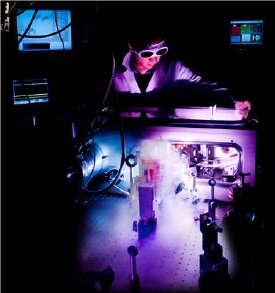Apr 13 2010
Physicists of the Max Born Institute in Berlin report in the latest issue of Physical Review Letters that electrons in semiconductor crystals have a negative inertial mass when strongly accelerated in an electric field.
Isaac Newton found in the 17th century that a force causes a body to accelerate. The inertial mass of the body is the ratio between force and acceleration, thus, given the same force, a light body is accelerated more strongly than a heavy body. A body's mass is positive, meaning that the acceleration is in the same direction as the force. Charged elementary particles as the free electron, which has a mass of only 10 to the power of -30= 0. ...(29 zeros !)...1 kilograms, can be accelerated in electric fields to extremely high speeds.
 Wilhelm Kuehn aligning the experiment. Photo: Uwe Bellhäuser
Wilhelm Kuehn aligning the experiment. Photo: Uwe Bellhäuser
If the electric field is small, the motion of electrons in crystals is governed by the same laws. In this regime, the mass of a crystal electron is only a small part of the mass of a free electron.
Researchers from the Max Born Institute in Berlin have now demonstrated that crystal electrons in extremely high electric fields exhibit a completely different behavior. Their mass even becomes negative. They report in the latest issue of Physical Review Letters that the electron is accelerated within the extremely short time of 100 femtoseconds = 0.000 000 000 000 1 seconds to a speed of 4 million kilometers per hour. Afterwards the electron comes to a stop and even moves backward. This means that the acceleration is in opposite direction to the force, which can only be explained by a negative inertial mass of the electron.
In the experiments, electrons in the semiconductor crystal gallium arsenide are accelerated by an extremely short electrical pulse with a field strength of 30 million Volts per meter. At the same time the speed of the electrons is measured with high precision as a function of time. The duration of the electric pulse is only 300 femtoseconds. This extremely short duration is essential as otherwise the crystal could be damaged.
The new results agree with calculations of the Nobel Prize winner Felix Bloch undertook more than 80 years ago. They open up a new regime of charge transport with new possibilities for future microelectronics devices. The observed frequencies are in the terahertz range (1 THz = 1000 GHz = 10 to the power of 12Hz), about 1000 times higher than the clock rate of the newest PCs.